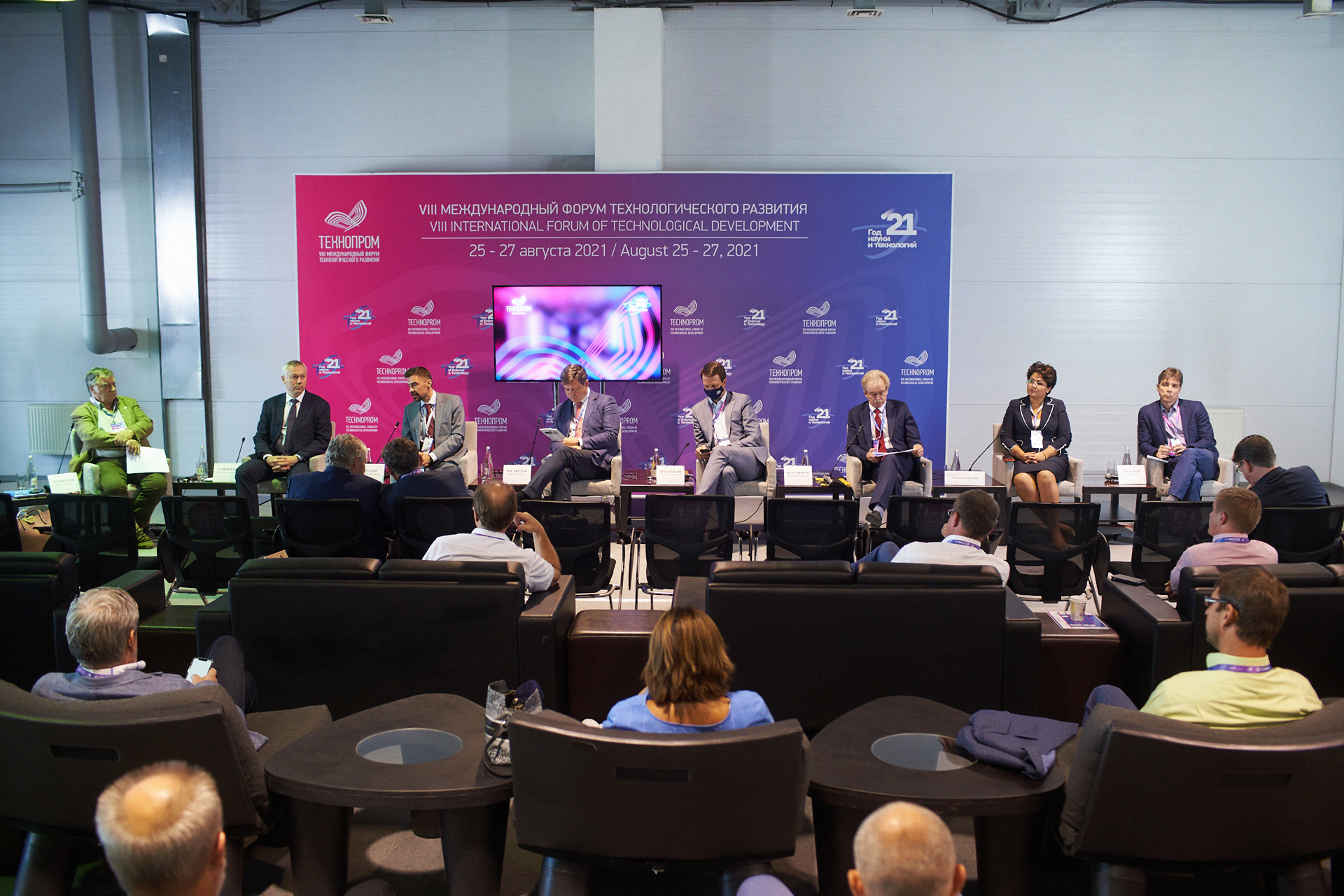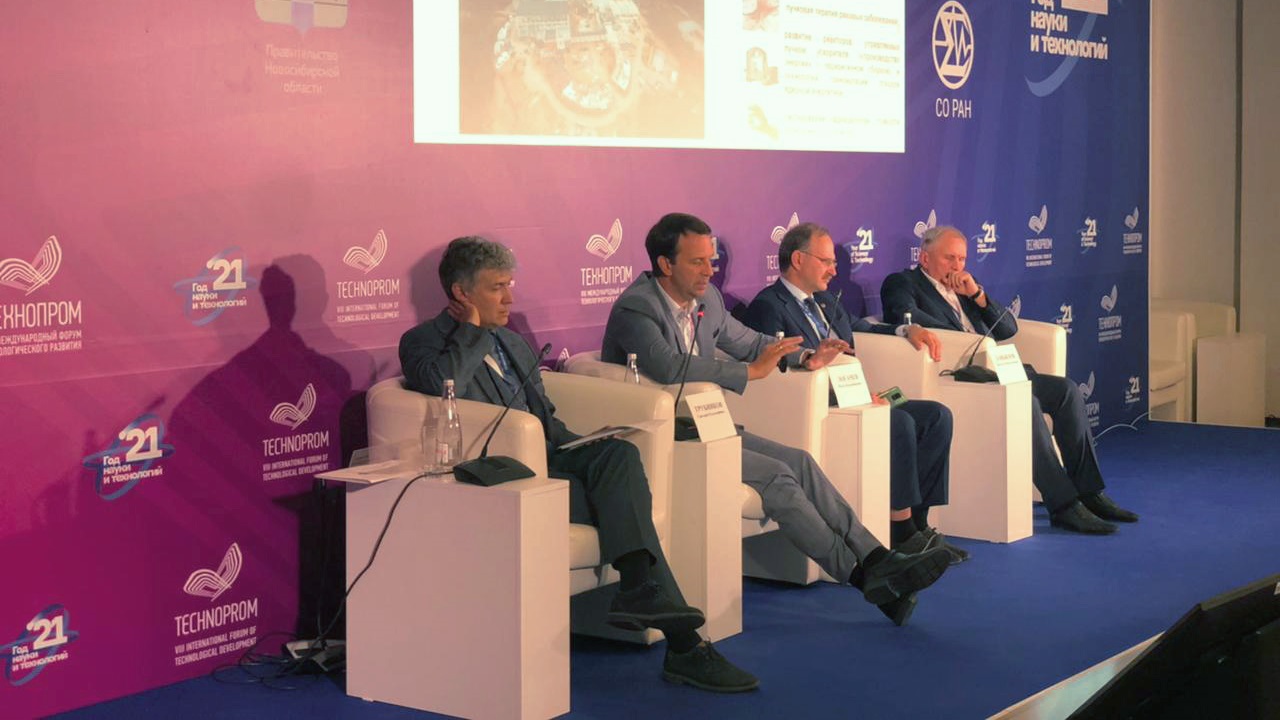Grigory Trubnikov at “Technoprom-2021”: university as assembly point for science city 2.0
News, 27 August 2021
At the strategic session “Archipelago2121: development of science cities and high-tech territories” on 26 August, JINR Director Grigory Trubnikov stated that modern university as a tandem of urbanism, science, and innovation would be an attraction point for talented young people, without whom the development of science cities and high-tech territories is impossible. Moreover, on the second day of “Technoprom-2021”, Grigory Trubnikov moderated the round table “Megascience facilities for ensuring scientific and technological leadership”, as well as took part in the meeting of the State Council Commission for Science of the Russian Federation.
It was a discussion about the role of science cities and other high-tech and innovative programmes for the implementation of the programme of the scientific and technological development of Russia. Grigory Trubnikov presented his vision of a new model of science cities. “It is obvious that science should be at the forefront in science cities 2.0. However, the fast transfer of acquired fundamental and search knowledge into innovations, i.e. new products, is also important,” he said.
Participants of the session noted that the development of science cities is ensured by the influx of talented young people. The attraction of them is impossible without a comfortable social urban environment. “If we talk about a federal project on the development of science cities in the framework of a new state programme of the Russian Federation, then the core of such a programme should be the development of a modern international comfortable city environment,” the Institute’s Director highlighted. “In other words, it is necessary to spend resources for urbanism, ecology, social insurance, safety, and logistics.” Grigory Trubnikov believes that a university may serve as an assembly point for all the constituents mentioned above – urbanism, science, and innovation.
The main topic of the discussion at the round table “Megascience facilities for ensuring scientific and technological leadership” was ensuring Russia’s leading positions in the world scientific arena.
Opening the discussion, Grigory Trubnikov outlined topical, urgent issues: what are the criteria for assessing the efficiency of international facilities for the creation and maintenance of which considerable funds are spent? Should researchers be moved by fundamental science or applied tasks?
Other central topics of the discussion were necessary scales of projects in Russia, ways of achieving international attraction of projects, building a reasonable balance between research of Russian scientists in Russia and abroad.
Grigory Trubnikov spoke about the participation of the country in foreign projects abroad and about the return of part of the funds spent for these projects, “Russia plays key roles in the largest international megascience projects. For example, the ITER reactor in France where Russia’s contribution is more than a billion euro. Another project is the XFEL Free-Electron Laser recently commissioned in Hamburg. One more project is the ESRF in Grenoble, France, and the FAIR project being constructed in Germany. In the frames of each of them, Russia has a contribution in the implementation of 3 – 27 %. In my opinion, it is important to discuss both the intellectual contribution to the world programme of development of such facilities and, what is very important, the efficient industrial return since 60 – 80 % of funds Russia contributes in the form of finance and resources then return to the Russian Federation in the form of high-tech orders.” The JINR Director noted this cooperation to be effective, pragmatic, and mutually beneficial. It also gives Russia a look of an absolutely full-fledged, leading player in the fields of large-scale research facilities.
At the same time, participants of the event expressed a general opinion that one of the global tasks in the fields of megascience facilities is the training of highly qualified specialists.
Grigory Trubnikov presented to participants of the discussion the NICA megascience facility being constructed in Dubna. “The NICA accelerator has a wide programme of applied research that includes materials science, radiobiological research; production, transportation and storage of liquid gases, as well as modern energetics,” the JINR Director noted. He also reported on the current status of work on the creation of the facility, “Now, the collider is being actively assembled, and at the end of 2022 – the beginning of 2023, we will start the first work on setting up the beam circulation in the collider and preparation for the first physical experiments.”
The discussion was also attended by Representative of the JINR Director for Cooperation with International and Russian Organizations Boris Sharkov, Governor of the Novosibirsk region Andrey Travnikov, Director of the NRC “Kurchatov Institute” Alexander Blagov, VNIIEF Deputy Director Vasily Neznamov, INR SB RAS Director Pavel Logachev, INR SB RAS Deputy Director Ivan Logashenko (moderator of the discussion), VNIIEF Director Nikolay Zavialov, Dean of the MSU Faculty of Physics and one of the founders of the Baikal-GVD project Nikolay Budnev, Director for Digitalisation of the Rosatom’s “Proryv” project Andrey Fedorovsky, and Coordinator of the CLIC project in CERN Lucie Linssen. A laureate of the Nobel Prize in Physics Barry Barish sent his video message to participants of the session.
Grigory Trubnikov on global climate agenda at Technoprom-2021

